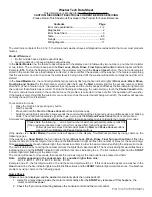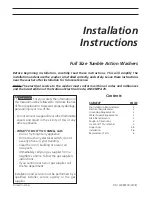
Page 11 — English
OPERATION
ADDING GASOLINE TO THE FUEL TANK
See Figure 12.
WARNING:
Gasoline and its vapors are highly flammable and
explosive. To prevent serious personal injury and prop-
erty damage, handle gasoline with care. Keep away from
ignition sources, handle outdoors only, do not smoke
while adding fuel, and wipe up spills immediately.
When adding gas to the pressure washer, make sure the unit
is sitting on a flat, level surface. If the engine is hot, let the
pressure washer cool before adding gas. ALWAYS fill the
fuel tank outdoors with the machine turned off.
NOTE: This is a 4-cycle engine. DO NOT mix fuel and
lubricant together.
Mix fuel stabilizer with gasoline according to fuel stabilizer
manufacturer’s directions.
Before removing the fuel cap, clean the area around it.
Remove the fuel cap.
Insert a clean funnel into the fuel tank then slowly
pour gasoline into the tank. Fill tank to approximately
1-1/2 in. below the top of the tank neck (this allows for
fuel expansion).
Replace fuel cap and tighten until the cap “clicks”.
Clean up any spills before starting the engine.
PUMP LUBRICANT
The pressure washer pump has been filled with sufficient
lubricant at the factory. You do not need to check or add
lubricant to the pump.
STARTING AND STOPPING THE PRESSURE
WASHER
See Figures 13 - 14.
NOTICE:
Do not run the pressure washer pump without water sup-
ply connected and turned on, as this may damage the
high pressure seals and decrease pump life. Completely
unwind the hose from its reel or coil and make sure the
hose is not being restricted by tires, rocks, or any other
objects that may lessen or prevent water flow to the
pressure washer.
Before starting the engine:
Connect all hoses.
Check all fluids (lubricant and gas).
Turn on the garden hose then pull the trigger to
relieve air pressure; hold the trigger until a steady stream
of water appears.
NOTE: Make sure the faucet is turned on fully and that
there are no kinks or leaks in the hose.
To start the engine:
Turn the fuel valve to the ON position.
Put the ON/OFF switch in the ON position.
Push primer bulb 3 times.
NOTE: If starting the engine for the first time, push the
primer bulb 5 times.
Grasp the recoil starter and pull slowly until resistance is
felt. Give the starter grip and rope a short, brisk pull to
start the engine.
NOTE: Do not allow the starter grip and rope to snap
back after starting; return it gently to its original place.
NOTICE:
If the engine does not start after each pull of the starter
grip and rope, squeeze the trigger to relieve water pres-
sure before attempting to start the engine again.
To stop the engine:
Put the engine switch in the OFF position.
Turn the fuel valve to the OFF position.
NOTE: Shutting OFF ( O ) the engine will not relieve pres-
sure in the system.
Pull trigger to release water pressure.
To stop the engine in an emergency situation:
Put the engine switch in the OFF position.
WARNING:
Hold the handle and wand securely with both hands. Ex-
pect the trigger handle to move when the trigger is pulled
due to reaction forces. Failure to do so could cause loss
of control and injury to yourself and others.
USING THE SPRAy WAND TRIGGER
See Figure 15.
Pull back and hold the trigger to operate the pressure
washer.
Release the trigger to stop the flow of water through the
nozzle.
To engage the lock out:
Push up on the lock out until it clicks into the slot.
To disengage the lock out:
Push the lock out down and into its original position.
To use the spray wand, start with the nozzle 1-2 ft. away
from the cleaning surface. Carefully approach the surface
just until the desired level of cleaning is achieved. If the spray
is too close it can damage the cleaning surface.
Summary of Contents for PS80516A
Page 43: ...Page P gina 21 NOTES NOTAS...
















































